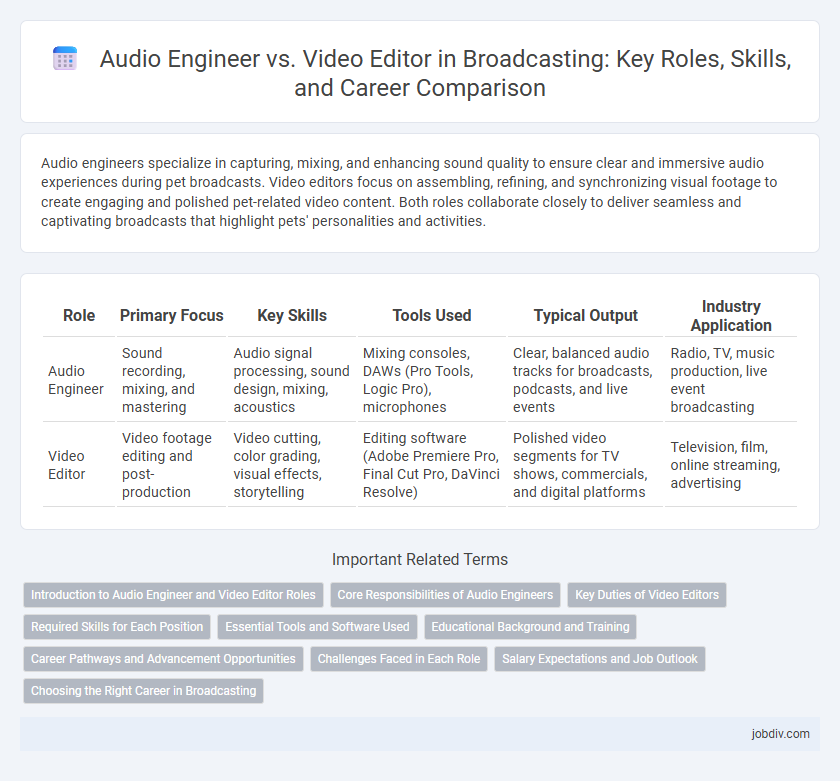Audio engineers specialize in capturing, mixing, and enhancing sound quality to ensure clear and immersive audio experiences during pet broadcasts. Video editors focus on assembling, refining, and synchronizing visual footage to create engaging and polished pet-related video content. Both roles collaborate closely to deliver seamless and captivating broadcasts that highlight pets' personalities and activities.
Table of Comparison
| Role | Primary Focus | Key Skills | Tools Used | Typical Output | Industry Application |
|---|---|---|---|---|---|
| Audio Engineer | Sound recording, mixing, and mastering | Audio signal processing, sound design, mixing, acoustics | Mixing consoles, DAWs (Pro Tools, Logic Pro), microphones | Clear, balanced audio tracks for broadcasts, podcasts, and live events | Radio, TV, music production, live event broadcasting |
| Video Editor | Video footage editing and post-production | Video cutting, color grading, visual effects, storytelling | Editing software (Adobe Premiere Pro, Final Cut Pro, DaVinci Resolve) | Polished video segments for TV shows, commercials, and digital platforms | Television, film, online streaming, advertising |
Introduction to Audio Engineer and Video Editor Roles
Audio engineers specialize in capturing, mixing, and enhancing sound quality for various broadcasting formats, employing techniques such as equalization, compression, and noise reduction to ensure clear and balanced audio output. Video editors focus on assembling raw footage, applying visual effects, color correction, and transitions to create cohesive and engaging video content tailored to broadcast standards. Both roles require proficiency with industry-standard software, but audio engineers emphasize sound design and acoustics while video editors prioritize visual storytelling and timing.
Core Responsibilities of Audio Engineers
Audio engineers are responsible for capturing, mixing, and mastering sound to ensure high-quality audio in broadcasting productions. They manage microphones, soundboards, and audio software to balance levels, reduce noise, and enhance clarity. Precise audio synchronization with video content is essential to maintain seamless viewer experience.
Key Duties of Video Editors
Video editors specialize in assembling raw footage into a cohesive final product, focusing on cutting, sequencing, and enhancing visual content to tell a compelling story. Their key duties include color correction, applying visual effects, and syncing audio tracks to ensure smooth transitions and polished presentations. Unlike audio engineers who concentrate on sound quality and mixing, video editors prioritize visual storytelling and continuity within broadcasting projects.
Required Skills for Each Position
Audio engineers require expertise in sound mixing, audio signal flow, and proficiency with digital audio workstations (DAWs) such as Pro Tools or Logic Pro to deliver high-quality sound production. Video editors must master nonlinear editing software like Adobe Premiere Pro or Final Cut Pro, along with skills in color grading, motion graphics, and storytelling to create cohesive video narratives. Both roles demand a keen sense of timing and attention to detail, yet audio engineers specialize in acoustic manipulation while video editors focus on visual composition and seamless transitions.
Essential Tools and Software Used
Audio engineers rely heavily on tools like digital audio workstations (DAWs) such as Pro Tools, Logic Pro, and Ableton Live for mixing, mastering, and sound design. Video editors use software such as Adobe Premiere Pro, Final Cut Pro, and DaVinci Resolve to assemble, color grade, and fine-tune footage. Both roles often utilize hardware like high-quality headphones, audio interfaces, and control surfaces to enhance precision and workflow efficiency.
Educational Background and Training
Audio engineers typically hold degrees in audio production, sound engineering, or music technology, with hands-on training in acoustics, mixing consoles, and digital audio workstations (DAWs). Video editors usually pursue education in film production, multimedia, or digital storytelling, gaining expertise in software like Adobe Premiere Pro and Final Cut Pro through both academic programs and industry certifications. Both roles require internships or practical experience to master specialized equipment and editing techniques essential for broadcasting quality content.
Career Pathways and Advancement Opportunities
Audio engineers specialize in sound design, mixing, and recording, often advancing by gaining expertise in studio technology, live sound engineering, or broadcast audio production. Video editors focus on cutting, sequencing, and visual storytelling, with career growth tied to mastering editing software, visual effects, and narrative techniques in film and television. Both roles offer pathways into roles like post-production supervisor or multimedia producer, benefiting from cross-disciplinary skills in digital media and content delivery systems.
Challenges Faced in Each Role
Audio engineers often face challenges related to sound clarity, background noise elimination, and balancing multiple audio tracks in diverse environments. Video editors must overcome difficulties in synchronizing footage, color grading consistency, and managing large file sizes under tight deadlines. Both roles require advanced technical skills and attention to detail to ensure high-quality broadcast content.
Salary Expectations and Job Outlook
Audio engineers in broadcasting typically earn between $45,000 and $75,000 annually, with demand driven by the expansion of streaming platforms and live events production. Video editors can expect salaries ranging from $40,000 to $70,000, benefiting from the growth in digital content creation and multimedia advertising. Both roles show positive job outlooks, but audio engineers often command higher wages due to specialized technical skills and increasing audio quality standards in media.
Choosing the Right Career in Broadcasting
Audio engineers specialize in sound design, mixing, and recording, ensuring high-quality audio for broadcasts, while video editors focus on assembling, cutting, and enhancing visual footage to create compelling narratives. Choosing the right career in broadcasting depends on your skill set and passion for either auditory elements or visual storytelling, with audio engineering requiring expertise in acoustics and signal processing, and video editing demanding proficiency in software like Adobe Premiere Pro or Final Cut Pro. Both roles are essential in producing polished broadcast content, offering diverse opportunities in television, radio, and digital media industries.
Audio Engineer vs Video Editor Infographic

 jobdiv.com
jobdiv.com